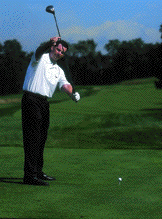|
|
8 Reasons Why Players Have Trouble Hitting Driver
by Golf Illustrated
 The driver could be considered a double-edged sword. It is the most fun to hit, but at the same time can be the most frustrating. It can make or break your score depending on whether you play aggressively or defensively. The driver could be considered a double-edged sword. It is the most fun to hit, but at the same time can be the most frustrating. It can make or break your score depending on whether you play aggressively or defensively.
The driver is the most difficult club to hit because it is the longest, swings the fastest and has the least amount of loft. Therefore, any mistake is exaggerated when compared to mistakes made with other clubs. But in order to fix your mistakes, you must understand why and how they occur.
How To Avoid Pop-Ups
The driver can generate some very exaggerated ball-flight patterns. Although these mistakes are frustrating, they can help you key in on the exact problems in your swing.
Pop-ups are shots that fly high and short. After the ball is struck, there?s usually an ugly mark on the top of the club. A common misconception is that these shots are caused by teeing the ball too high, but there are many different reasons why pop-ups occur.
One major error that often leads to pop-ups is a steep angle of attack. This causes the club to hit down on the ball, resulting in the ball contacting the top of the driver. Teeing the ball lower is thought to be a quick fix for this fault, but it will actually exacerbate the problem.
A sweeping action is necessary to cure a steep angle of attack, which is often created by an outside-to-inside swing path. A good practice drill to develop this sweeping motion is to swing a club a few inches above the ball. This will help flatten out the swing plane in the downswing and put it on a more inside-to-out swing path. It will feel similar to a baseball swing.
Pop-ups also occur when the ball is positioned too far back in the stance. This leads to the head moving in front of the ball, creating a steep angle of attack. To correct this problem, lay several clubs on the ground to help you monitor your ball position.
Improper body motion in the downswing is another cause of a steep angle of attack. Instead of the lower body initiating the move into the ball, the head or upper body moves first. With the upper body behind the ball in the backswing, a better transition is needed to begin the downswing.
The best way to cure this swing flaw is to practice body-motion drills in front of a mirror. Focus on your hips leading the downswing while your head stays behind the ball at impact ...
back |
|